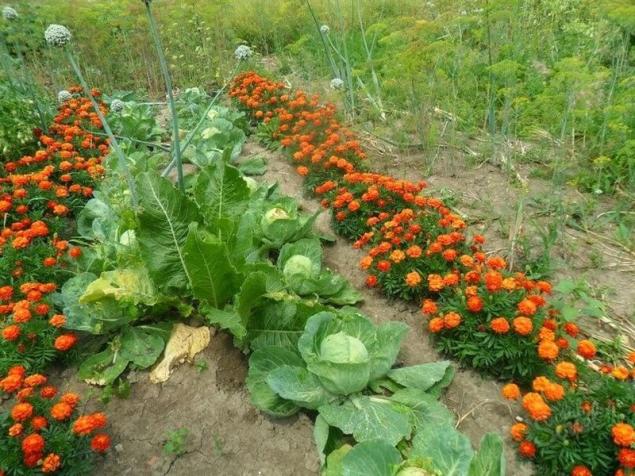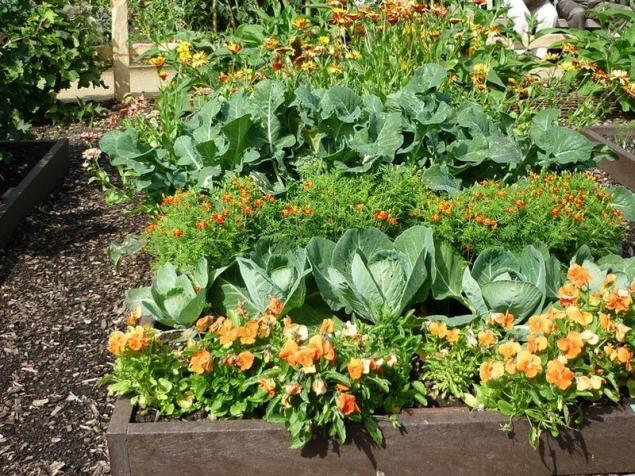652
How to get a bumper crop on ogorode- reveal secrets!
Farmers have long noticed that the plants affect other plants, and tried to use this influence to increase the yield. Plants-pals promote active growth, development and fruiting of each other, and also deter pests and attract beneficial insects.
Reasons for joint landings:

1. Physical barriers
Higher plants provide natural protection lower from direct sun, high winds and garden pests. They create a favorable climate for its smaller neighbors.

2. FERTILIZER
Legumes recovered from the deep layers of the soil and accumulate in their root system nitrogen, which can take advantage of their nearest neighbors. Read more about green manure - Plants, which are called "green manure»
. 3. attract beneficial insects and birds
The bright, fragrant and full of the nectar of the flowers attract bees and butterflies, which at the same time "on the road" and sit down on the flowers nearby fruit crops, and increasing their pollinating crops. Many plants attract birds and beneficial insects that are (or larva) is naturally destroy pests.
4. repel pests - insects and rodents
Many aromatic herbs disorient their insect odor and stripped them of vegetable crops. Others, however, attract the insects to him, distracting them from vegetables. It is believed that onions repel rabbits and hares, and the elder - mice. Marigolds (tagetes) hid from worms, root crops of vegetables growing nearby.
5. CHEMICAL EXPOSURE - allelopathy
The mutual or one-sided influence of plants on each other through the isolation of biologically active substances (volatile production, Colin, antibiotics, etc.) Is called allelopathy. Already mentioned marigolds are one of the most influential plants. Along with other substances, they produce thiophene having a pungent odor. It is believed that marigolds can dislodge from his entourage bindweed - one of the most vicious (though beautiful) weeds
. The effect of allelopathy should be considered not only in the joint planting of vegetables, but also during storage and transportation of the crop (eg, bananas and apples emit ethylene, which contribute to more rapid maturation and further degradation of other fruits in the vicinity), as well as in the preparation of compositions from cut flowers .
6. IMPROVING THE TASTE OF FRUIT
Some gardeners believe that certain plants are able to even improve the taste of the fruits of their neighbors. For example, many aromatic herbs (primarily basil and Monarda) enhance the flavor of tomatoes. It can be assumed that these plants accumulate some useful elements and enrich their soil around them.
Good Neighbors - the key to successful harvests
! In nature, there are no large areas occupied by one species. In the meadow is always a mixture of herbs in the forest - not only different species of trees, but also shrubs, herbs, mosses. Even in the field, where planted after plowing only one culture, grow weeds. We can also create a garden where plants coexist.

Of course, there will be undesirable "aliens," but they will not cause any harm. This is because the rich, diverse ecosystem is in equilibrium! How to do it? The answer is simple - apply the method of mixed plantings. To do this, you must know what plants are good neighbors, and to plan the territory so as to ensure the closer proximity of different cultures as possible. They shall grow not large arrays, and in the adjacent rows or holes.
On the border - better
It has long been noticed, plants grow better on the border of different ecosystems: on the edge of the forest, on the shore, on the edge of the field. To recreate the border effect I use a spiral flower bed. She curled into a spiral border and there is room for a variety of micro-climatic areas: the higher - the drier and warmer, there are shady and sunny side. Usually spiral flower bed plants are planted pryanoaromatnye.
That version of the sequence of plants: sorrel, valerian, onions, peppermint, clary sage, Salvia nemorosa, garden thyme, oregano, strawberry, Salvia officinalis, thyme, rosemary
. You can simply alternate rows, referring to crop compatibility table. However, we must remember that plants influence each other depends on the conditions in which they grow. Sometimes in large quantities they oppress its neighbors, and in moderation - are helpers. In general, you will need your creativity and observation.
Compatibility cultures
First of all, select the main crops (eg, tomatoes). Then pick up a neighbor who has a positive effect on the main plant. In our case, it may be a salad or spinach - they will harvest before the tomatoes begin to bear fruit. High green tomato plants protect from direct sunlight and create a more favorable climate for them. Salad after harvest to sow again. It is necessary to put a number of herbs that repel pests. Just need to make sure that they do not drown out the main culture.
Understand and ripening of the crop. If you take away one culture before it is to find plant-changer. You can not leave the ground bare. Her mulch, planted green manure.
When choosing crops should pay attention to reduce competition between them:
Plants with deep root systems get along better with those who have roots lie shallow;
species with low nutritional requirements will not prevent those who need a lot of nutrients;
high spreading culture protection from the sun, those who love the light penumbra.
Only the demand for water from neighbors should be similar.
Plants with deep root system:
- Eggplant, beans (except peas), cabbage, leeks, carrots, parsnips, peppers, radishes, beets, celery root, tomatoes, pumpkin
. Plants with shallow root system:
- Salad, peas, potatoes, kohlrabi, watercress, corn, onions, cucumbers, parsley, celery leaf, radish, melon, spinach
. Mixed planting serves several functions:
protection of plants from diseases and pests,
increase in yield from the area,
unit soil protection against unilateral depletion,
reducing the number of weeds.
Fruits and vegetables growing in a community with other species, delicious mint improves the taste of potatoes, parsley - tomato
. If you choose the right plants, they will help each other and to please the master. This is the most efficient use of your plot of land.
Intercropping and planting together for a long time used in his garden by experienced owners. Carrots sown through row with onion, cabbage beds cased savory potatoes - beans. A plant such nurses as calendula, marigolds and nasturtium grow around the garden.
Reasons for joint landings:

1. Physical barriers
Higher plants provide natural protection lower from direct sun, high winds and garden pests. They create a favorable climate for its smaller neighbors.

2. FERTILIZER
Legumes recovered from the deep layers of the soil and accumulate in their root system nitrogen, which can take advantage of their nearest neighbors. Read more about green manure - Plants, which are called "green manure»
. 3. attract beneficial insects and birds
The bright, fragrant and full of the nectar of the flowers attract bees and butterflies, which at the same time "on the road" and sit down on the flowers nearby fruit crops, and increasing their pollinating crops. Many plants attract birds and beneficial insects that are (or larva) is naturally destroy pests.
4. repel pests - insects and rodents
Many aromatic herbs disorient their insect odor and stripped them of vegetable crops. Others, however, attract the insects to him, distracting them from vegetables. It is believed that onions repel rabbits and hares, and the elder - mice. Marigolds (tagetes) hid from worms, root crops of vegetables growing nearby.
5. CHEMICAL EXPOSURE - allelopathy
The mutual or one-sided influence of plants on each other through the isolation of biologically active substances (volatile production, Colin, antibiotics, etc.) Is called allelopathy. Already mentioned marigolds are one of the most influential plants. Along with other substances, they produce thiophene having a pungent odor. It is believed that marigolds can dislodge from his entourage bindweed - one of the most vicious (though beautiful) weeds
. The effect of allelopathy should be considered not only in the joint planting of vegetables, but also during storage and transportation of the crop (eg, bananas and apples emit ethylene, which contribute to more rapid maturation and further degradation of other fruits in the vicinity), as well as in the preparation of compositions from cut flowers .
6. IMPROVING THE TASTE OF FRUIT
Some gardeners believe that certain plants are able to even improve the taste of the fruits of their neighbors. For example, many aromatic herbs (primarily basil and Monarda) enhance the flavor of tomatoes. It can be assumed that these plants accumulate some useful elements and enrich their soil around them.
Good Neighbors - the key to successful harvests
! In nature, there are no large areas occupied by one species. In the meadow is always a mixture of herbs in the forest - not only different species of trees, but also shrubs, herbs, mosses. Even in the field, where planted after plowing only one culture, grow weeds. We can also create a garden where plants coexist.

Of course, there will be undesirable "aliens," but they will not cause any harm. This is because the rich, diverse ecosystem is in equilibrium! How to do it? The answer is simple - apply the method of mixed plantings. To do this, you must know what plants are good neighbors, and to plan the territory so as to ensure the closer proximity of different cultures as possible. They shall grow not large arrays, and in the adjacent rows or holes.
On the border - better
It has long been noticed, plants grow better on the border of different ecosystems: on the edge of the forest, on the shore, on the edge of the field. To recreate the border effect I use a spiral flower bed. She curled into a spiral border and there is room for a variety of micro-climatic areas: the higher - the drier and warmer, there are shady and sunny side. Usually spiral flower bed plants are planted pryanoaromatnye.
That version of the sequence of plants: sorrel, valerian, onions, peppermint, clary sage, Salvia nemorosa, garden thyme, oregano, strawberry, Salvia officinalis, thyme, rosemary
. You can simply alternate rows, referring to crop compatibility table. However, we must remember that plants influence each other depends on the conditions in which they grow. Sometimes in large quantities they oppress its neighbors, and in moderation - are helpers. In general, you will need your creativity and observation.
Compatibility cultures
First of all, select the main crops (eg, tomatoes). Then pick up a neighbor who has a positive effect on the main plant. In our case, it may be a salad or spinach - they will harvest before the tomatoes begin to bear fruit. High green tomato plants protect from direct sunlight and create a more favorable climate for them. Salad after harvest to sow again. It is necessary to put a number of herbs that repel pests. Just need to make sure that they do not drown out the main culture.
Understand and ripening of the crop. If you take away one culture before it is to find plant-changer. You can not leave the ground bare. Her mulch, planted green manure.
When choosing crops should pay attention to reduce competition between them:
Plants with deep root systems get along better with those who have roots lie shallow;
species with low nutritional requirements will not prevent those who need a lot of nutrients;
high spreading culture protection from the sun, those who love the light penumbra.
Only the demand for water from neighbors should be similar.
Plants with deep root system:
- Eggplant, beans (except peas), cabbage, leeks, carrots, parsnips, peppers, radishes, beets, celery root, tomatoes, pumpkin
. Plants with shallow root system:
- Salad, peas, potatoes, kohlrabi, watercress, corn, onions, cucumbers, parsley, celery leaf, radish, melon, spinach
. Mixed planting serves several functions:
protection of plants from diseases and pests,
increase in yield from the area,
unit soil protection against unilateral depletion,
reducing the number of weeds.
Fruits and vegetables growing in a community with other species, delicious mint improves the taste of potatoes, parsley - tomato
. If you choose the right plants, they will help each other and to please the master. This is the most efficient use of your plot of land.
Intercropping and planting together for a long time used in his garden by experienced owners. Carrots sown through row with onion, cabbage beds cased savory potatoes - beans. A plant such nurses as calendula, marigolds and nasturtium grow around the garden.
She wrapped toes plaster. Having the power of this technique, doing so ever!
Pancakes with spirulina - useful and unusual!
























